1. Key points
In 2011, the income generated by businesses in the UK, less the cost of goods and services used to create this income was estimated to be £977.4 billion. This amount represents the approximate Gross Value Added at basic prices (aGVA) of the UK Business Economy
Between 2010 and 2011, aGVA recorded a rise of 5.8% (£53.8 billion). This increase is a continuation of the recovery seen between 2009 and 2010 and takes aGVA to a level 1.4% (£13.5 billion) above that seen in 2008, at the start of the recession
The Service sector, which accounts for over half of aGVA in the UK Business Economy, led this recovery with aGVA rising 5.7% (£28.1 billion) between 2010 and 2011, the second consecutive annual increase, taking it above the level seen in 2008
In Distribution, Production and Construction there was suppressed growth in aGVA between 2010 and 2011 due to purchase costs increasing at a faster rate than turnover
Construction had the slowest rate of growth and, unlike the other sectors where aGVA is now close to or above the 2008 level, aGVA remains below that seen in 2008
When compared to the ABS Provisional results published on 15 November 2012, these revised results show minimal revision for the UK Business Economy. There were upward revisions of 0.6% (£19.2 billion) in turnover, 0.6% (£15.0 billion) in purchases and 0.3% (£3.3 billion) in aGVA. The direction of movements of aGVA for the broad industry groups remain unchanged
2. Overview
This release provides an estimate of the size and growth of the UK Business Economy for 2011 as measured by the Annual Business Survey (ABS). It is the key resource for understanding the detailed structure, conduct and performance of businesses across the UK. The release covers production, construction, distribution, services and parts of agriculture, which together represent the UK Business Economy. Together these industries represent around two thirds of the whole economy of the UK in terms of Gross Value Added. Public administration and defence, public sector health and education and parts of agriculture and finance make up the difference between the UK Business Economy and the whole economy.
Estimates published in this release include turnover, purchases, approximate Gross Value Added at basic prices (aGVA) and employment costs. All data are reported at current prices (effect of price changes included). Where the recession is mentioned it refers to the 'first dip' which started in 2008 rather than the subsequent recession which began at the end of 2011. For more information about the survey see the background notes.
The ABS has a wide range of uses: for example, ABS statistics are essential contributors to the UK National Accounts, including the measurement of Gross Domestic Product (GDP), they are supplied to Eurostat to meet the requirements of the European Structural Business Statistics (SBS) Regulation, and are used by the Devolved Administrations and central and local government to monitor and inform policy development. For other uses see background note 3.
One question often asked of the ABS release is ‘how does the measure of aGVA differ from the GVA measure in the National Accounts?’. The difference is that the ABS measure does not fully allow for some National Accounts concepts such as taxes, subsidies or income earned in kind and is therefore only approximate. Adjustments for these components are made in the calculation of GVA in the National Accounts, which also cover parts of the economy not included in ABS such as the public sector and parts of agriculture and financial services. For further information on aGVA see background note 8.
ONS makes every effort to provide informative commentary on the data in this release. Where possible, the commentary draws on evidence from businesses or other sources of information to help explain possible reasons behind the observed changes. However, in some places it can prove difficult to elicit detailed reasons for movements, for example, businesses may state a ‘change in the nature of business activity’. Consequently, it is not possible for all data movements to be fully explained.
Nôl i'r tabl cynnwys3. User engagement
We constantly aim to improve this release and its associated commentary. We would welcome any feedback you might have, and would be particularly interested in knowing how you make use of these data to inform your work. Please contact us via email: abs@ons.gov.uk or telephone Heather Bovill on +44 (0)1633 455107.
Nôl i'r tabl cynnwys4. UK business economy
In 2011, the income generated by businesses in the UK, less the cost of goods and services used to create this income was estimated to be £977.4 billion. This amount represents the approximate Gross Value Added at basic prices (aGVA) of the UK Business Economy. Between 2010 and 2011 aGVA increased by 5.8% (£53.8 billion); the second consecutive annual increase, taking it above the level seen in 2008, at the start of the recession. Growth between 2010 and 2011 was faster than that between 2009 and 2010.
The main drivers of aGVA are turnover, the main component of income, and purchases, the main component of the consumed goods and services. The consecutive annual increases seen in aGVA are a result of similar consecutive increases in both turnover and purchases. Turnover increased by 7.4% (£229.3 billion) between 2010 and 2011, while purchases of goods, materials and services increased at a higher rate of 8.6% (£184.7 billion), resulting in aGVA growth that was lower than growth for turnover. As with aGVA, turnover and purchases have now recovered to levels above those seen in 2008, at the start of the recession (see Figure 1).
The recession and recovery described by the ABS between 2008 and 2011 is broadly in line with Gross Domestic Product (GDP) figures published in the National Accounts. Both the ABS aGVA estimates and the National Accounts GDP estimates show a fall between 2008 and 2009 and increases between 2009 and 2010 and between 2010 and 2011.
To see which industries are included in the ABS measure of the UK Business Economy, refer to background note 8.
Figure 1: UK Business Economy (Sections A-S), details of income and expenditure and resulting aGVA, 2008-2011
Revised 2011 United Kingdom data
Source: Annual Business Survey (ABS) - Office for National Statistics
Download this chart Figure 1: UK Business Economy (Sections A-S), details of income and expenditure and resulting aGVA, 2008-2011
Image .csv .xlsAll of the broad industry groups showed recovery in aGVA levels following falls between 2008 and 2009 (see Figures 2 and 3).
Figure 2: UK Business Economy (Sections A-S), details of aGVA by Sector, 2008-2011
Revised 2011 United Kingdom data
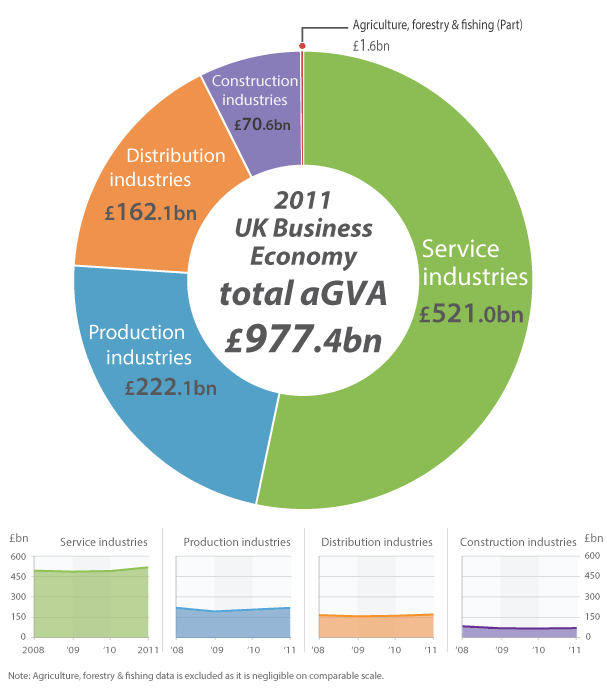
Source: Annual Business Survey (ABS) - Office for National Statistics
Services, the largest broad industry group, contributed most to overall growth. Service sector aGVA rose by £28.1 billion (5.7%) between 2010 and 2011, the second consecutive annual increase taking it to £521.0 billion, which is above the level seen in 2008.
Production, the second largest broad industry group, also saw growth in aGVA between 2010 and 2011, increasing by £13.2 billion (6.3%). This was below the 6.8% growth seen between 2009 and 2010. Despite two years of growth, aGVA for Production, at £222.1 billion in 2011, remains slightly lower than the total for 2008.
The Distribution sector also showed growth for the second consecutive year, with a £9.0 billion (5.9%) increase in aGVA between 2010 and 2011 taking it to £162.1 billion, again above the level seen in 2008.
The sectors for Construction and for Agriculture (part), forestry and fishing both show growth in aGVA between 2010 and 2011 for the first time in three years, but their respective estimated totals of £70.6 billion and £1.6 billion still remain lower than the levels in 2008, at the start of the recession.
Figure 3: UK business economy (sections A-S), details of aGVA growth by sector, 2008-2011
Revised 2011 United Kingdom data
Source: Annual Business Survey (ABS) - Office for National Statistics
Download this chart Figure 3: UK business economy (sections A-S), details of aGVA growth by sector, 2008-2011
Image .csv .xls5. Service industries (sections H-S)
Just over half of the £53.8 billion growth in aGVA between 2010 and 2011 for the UK Business Economy was generated by the Service industries. Over this period Service turnover increased at a faster rate than purchases, 5.1% compared to 4.5%, resulting in aGVA rising by 5.7% (£28.1 billion).
This continues the sector improvement seen between 2009 and 2010, with turnover, purchases and aGVA all now recovered to totals above those in 2008 at the start of the recession (see Figure 4).
Figure 4: Service Industries (Sections H-S), details of income and expenditure and resulting aGVA, 2008-2011
Revised 2011 United Kingdom data
Source: Annual Business Survey (ABS) - Office for National Statistics
Download this chart Figure 4: Service Industries (Sections H-S), details of income and expenditure and resulting aGVA, 2008-2011
Image .csv .xlsThe majority of the industries within the Service sector show increases in aGVA between 2010 and 2011 (see Figures 5 and 6). Those industries which have made the largest contributions to growth are Professional, scientific and technical activities (Section M), Administrative and support service activities (Section N), Information and communication (Section J) and Accommodation and food service activities (Section I). Together these industries accounted for an increase in aGVA of £23.3 billion.
Figure 5: Service industries (sections H-S), details of aGVA by section, 2008-2011
Revised 2011 United Kingdom data
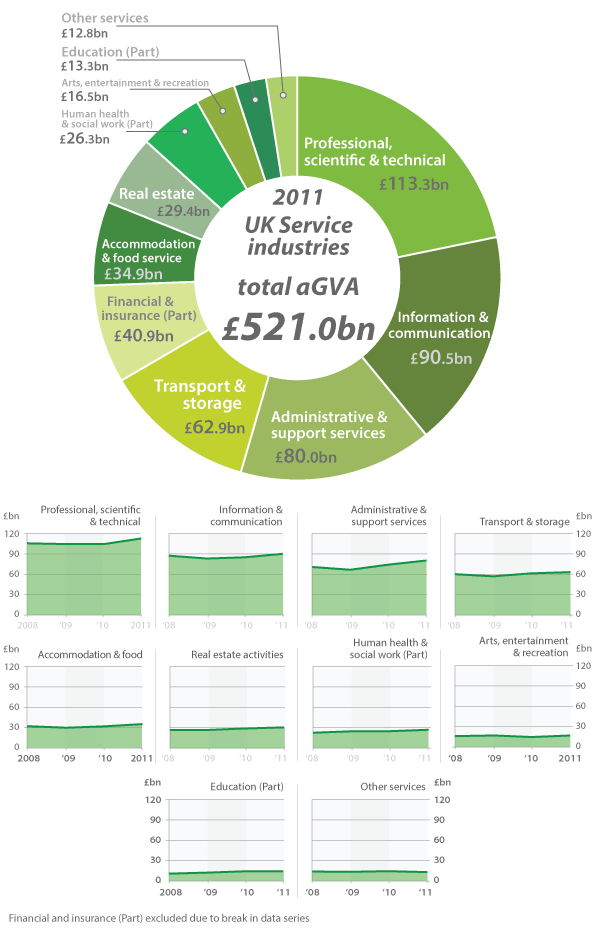
Source: Annual Business Survey (ABS) - Office for National Statistics
Notes:
- The sum of constituent items in this chart may not always agree exactly with the totals shown due to rounding
Professional, scientific and technical activities (section M)
Turnover in Professional, scientific and technical activities increased by 5.7% (£10.8 billion) between 2010 and 2011, with purchases showing an increase of only 4.0% (£3.4 billion). This resulted in growth of 8.2% (£8.6 billion) in aGVA, taking it above the level reported for 2008.
This broad section, which covers a range of industries from legal and accounting activities to advertising and market research and veterinary activities, saw increases in aGVA in almost all its divisions between 2010 and 2011. Those making the largest impact on aGVA growth were Activities of head offices; management consultancy and related activities (Division 70), Legal and accounting activities (Division 69) and Advertising and market research (Division 73). All three divisions showed healthy increases in turnover coupled with either decreasing or smaller increase in purchases.
Administrative and support activities (section N)
Between 2010 and 2011 Administrative and support activities saw turnover rise by 8.5% (£13.0 billion), while purchases increased by 8.7% (£6.8 billion) leading to an aGVA increase of 8.2% (£6.1 billion). As with Professional, scientific and technical activities, aGVA for Administrative and support activities is now above the level seen in 2008 at the start of the recession.
The main industries driving growth within Administrative and support activities were Rental and leasing activities (Division 77) where aGVA increased by 18.6% (£2.3 billion). This growth may be related to the current economic climate resulting in an increased tendency to rent or lease, as opposed to buying, for example vehicles and machinery. Office administration, office support and other business support activities (Division 82) and Travel agency, tour operator and other reservation service and related activities (Division 79) also made significant contributions to the increase in aGVA.
Information and communication (section J)
Information and communication experienced a 3.2% (£5.9 billion) rise in turnover, which, coupled with a very small 0.1% (£0.1 billion) fall in purchases, resulted in growth in aGVA of 6.0% (£5.2 billion) between 2010 and 2011. This took aGVA to a level 3.1% (£2.7 billion) higher than in 2008.
The majority of industries within Information and communication showed an increase in aGVA between 2010 and 2011, with the biggest driver of growth coming from Computer programming, consultancy and related activities (Division 62). Some businesses reported that they were taking cost cutting measures such as the disposal of fixed assets.
Accommodation and food service activities (section I)
Turnover in Accommodation and food service activities increased by 5.6% (£3.8 billion) between 2010 and 2011, with purchases rising by only 1.0% (£0.4 billion) resulting in an 11.2% increases in aGVA (£3.5 billion).
The main driver of the aGVA increase was Food and beverage serving services (Division 56). There may be a range of reasons for growth across this division. Some businesses, for example, reported expansion of restaurant chains during 2011 and others stated that sales in 2011 were less effected by snow than in 2010, when adverse weather was reported to have suppressed turnover.
Finance and insurance (section K(part))
Validation of data returns for 2011 have highlighted that a small number of businesses within the Finance and insurance sector were returning global figures rather than UK only. Results for 2011 and 2010 have been revised to reflect UK figures, but previous years (2008 and 2009) have not been revised and should therefore not be compared directly with 2010 and 2011.
Results for this sector are experimental and any comparisons between years should be undertaken with caution.
Figure 6: Service industries (sections H-S), details of aGVA growth by section, 2008-2011
Revised 2011 United Kingdom data
Source: Annual Business Survey (ABS) - Office for National Statistics
Notes:
- H - Transport and storage
- I - Accommodation and food service activities
- J - Information and communication
- L - Real estate activities
- M - Professional, scientific and technical activities
- N - Administrative and support service activities
- P (part) - Education
- Q (part) - Human health and social work activities
- R - Arts, entertainment and recreation
- S - Other service activities
- K (part) - Finance and insurance excluded due to break in data series
Download this chart Figure 6: Service industries (sections H-S), details of aGVA growth by section, 2008-2011
Image .csv .xls6. Production industries (sections B-E)
Around a quarter of the £53.8 billion growth in aGVA between 2010 and 2011 for the UK Business Economy was generated by the Production industries.
Both turnover and purchases saw an increase over the period, but unlike in the Service sector, purchases in the Production industries increased at a faster rate (8.9%, £38.1 billion) than turnover (7.2%, £46.7 billion). This is most likely the result of the rising costs of raw materials and the price of oil which may not have been passed on in full to customers, leading to depressed aGVA growth of 6.3% (£13.2 billion). This second year of growth leaves Production aGVA in 2011 just £0.4 billion short of the level in 2008 before the recession (see Figure 7).
Figure 7: Production Industries (Sections B-E), details of income and expenditure and resulting aGVA, 2008-2011
Revised 2011 United Kingdom data
Source: Annual Business Survey (ABS) - Office for National Statistics
Download this chart Figure 7: Production Industries (Sections B-E), details of income and expenditure and resulting aGVA, 2008-2011
Image .csv .xlsThere was growth in aGVA in all sections within Production between 2010 and 2011, but the continued recovery in Production was mainly driven by Manufacturing, which saw an increase in aGVA of £7.2 billion (4.9%) (see Figures 8 and 9). Both purchases and turnover increased for this sector, although the rise in purchases was higher than that for turnover (8.3% and 6.4% respectively), suppressing growth in aGVA.
Figure 8: Production Industries (Sections B-E), details of aGVA by Section, 2008-2011
Revised 2011 United Kingdom data
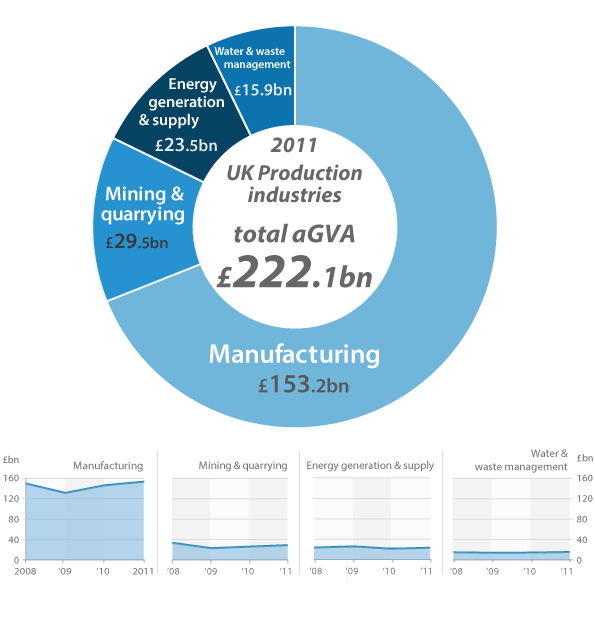
Source: Annual Business Survey (ABS) - Office for National Statistics
Manufacturing (section C)
The picture within Manufacturing was mixed: while the majority of divisions saw increases in aGVA between 2010 and 2011, eight of the 24 divisions experienced falls.
The growth in Manufacturing was driven primarily by Manufacture of machinery and equipment not elsewhere classified (n.e.c.) (Division 28), Manufacture of other transport equipment (Division 30), Manufacture of fabricated metal products, except machinery and equipment (Division 25) and Manufacture of motor vehicles, trailers and semi-trailers (Division 29). Together these four divisions accounted for an increase in aGVA of £5.3 billion.
There may be a range of reasons for growth across these divisions. Some businesses cited an upturn in business in 2011; others cited reduced headcount and streamlined working practices.
The Society of Motor Manufacturers and Traders suggest that growth in Motor vehicle manufacture (Division 29) in 2011 was driven by exports rather than domestic purchases of vehicles. In particular, emerging luxury car markets in locations such as Russia and China have increased demand for UK built models.
While not major drivers of the change in Production aGVA between 2010 and 2011, Mining and quarrying, Electricity, gas, steam and air conditioning supply and Water supply, sewerage, waste management, and remediation activities all showed a recovery in aGVA.
Mining and quarrying (section B, which includes oil and gas extraction)
Mining and quarrying saw increases of 15.0% (£7.2 billion) in turnover and 20.8% (£4.6 billion) in purchases resulting in 11.5% (£3.0 billion) growth in aGVA. The increase in purchases between 2010 and 2011 was partly due to the rise in global prices of gas and oil. These were likely to have been affected by the Arab spring uprisings and the Fukushima nuclear disaster.
Electricity, gas, steam and air conditioning supply (section D)
Electricity, gas, steam and air conditioning supply saw increases between 2010 and 2011 of 6.7% (£6.3 billion) in turnover and 7.6% (£5.5 billion) in purchases, with aGVA increasing by 9.0% (£1.9 billion). This increase takes aGVA close to the 2008 level, but still below the peak in 2009. This 2010 to 2011 growth is primarily driven by production of electricity and sale of electricity. Increased prices continue to be a driver of the growth in turnover, suspected to be influenced by the same factors as those identified for Mining and quarrying.
Water supply, sewerage, waste management, and remediation activities (section E)
Water supply, sewerage, waste management, and remediation activities saw an increase of 7.2% (£1.1 billion) in aGVA. Growth was driven by increases in aGVA for the Treatment and disposal of non-hazardous waste and Recovery of sorted materials such as recycling.
Figure 9: Production industries (sections B-E), details of aGVA growth by section, 2008-2011
Revised 2011 United Kingdom data
Source: Annual Business Survey (ABS) - Office for National Statistics
Download this chart Figure 9: Production industries (sections B-E), details of aGVA growth by section, 2008-2011
Image .csv .xls7. Distribution industries (section G)
Around a sixth of the £53.8 billion growth in aGVA between 2010 and 2011 for the UK Business Economy was generated by the Distribution industries.
The Distribution industries saw a 10.0% (£122.1 billion) rise in turnover and a 10.9% (£114.6 billion) increase in purchases between 2010 and 2011, resulting in 5.9% (£9.0 billion) growth in aGVA. This is the second consecutive year of growth, with the rate of growth picking up from that seen between 2009 and 2010; taking aGVA above the level seen in 2008 at the start of the recession (see Figure 10).
Figure 10: Distribution Industries (Section G), details of income and expenditure and resulting aGVA, 2008-2011
Revised 2011 United Kingdom data
Source: Annual Business Survey (ABS) - Office for National Statistics
Download this chart Figure 10: Distribution Industries (Section G), details of income and expenditure and resulting aGVA, 2008-2011
Image .csv .xlsPerformance within Distribution was mixed (see Figures 11 and 12). The growth in aGVA for Distribution was driven by Wholesale trade, except of motor vehicles and motorcycles (Division 46 – also referred to as Wholesale).
Figure 11: Distribution Industries (Section G), details of aGVA by Division, 2008-2011
Revised 2011 United Kingdom data
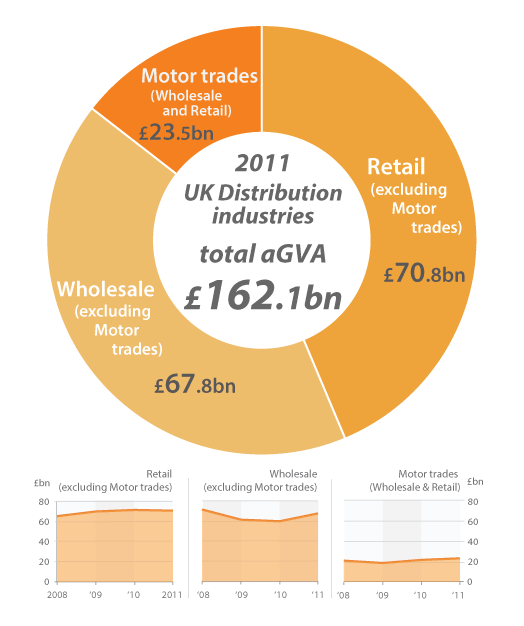
Source: Annual Business Survey (ABS) - Office for National Statistics
Wholesale (excluding motor trades) (division 46)
Wholesale saw an increase in aGVA between 2010 and 2011 for the first time since the series began in 2008, with Wholesale of solid, liquid and gaseous fuels (Class 46.71) driving the growth. The division saw a large increase in both turnover and purchases, both impacted by increased oil costs during 2011.
Motor trades (wholesale and retail) (division 45)
Motor trades also contributed to the growth in Distribution, with a growth in aGVA of 6.1% (£1.3 billion), as turnover increased at a higher rate than purchases (4.3% and 3.9% respectively between 2010 and 2011). This increase in aGVA was the second consecutive annual increase following a fall between 2008 and 2009.
Between 2009 and 2010, aGVA increased by 20.7% (£3.8 billion) largely due to the sale of new cars as the Government car scrappage scheme (which ran from May 2009 to April 2010) aided this industry. The market now looks to have changed in composition. Between 2010 and 2011 most of the increase in aGVA was generated from the Maintenance and repair of motor vehicles (Group 45.2), which saw an increase in aGVA of 16.6% (£1.0 billion). In contrast Sales of motor vehicles (Group 45.1) fell by 1.7% (£0.2 billion). This suggests that consumers may have brought forward purchases of new vehicles to take advantage of the scrappage scheme. It also aligns with the export driven increase in Manufacture of motor vehicles (Group 29.1) in the Production sector, suggesting that UK consumers are holding onto their vehicles and maintaining them rather than trading them in for a new model.
Retail (excluding motor trades) (division 47)
In contrast, aGVA in retail saw a decrease of 1.0% (£0.7 billion) between 2010 and 2011, although the general trend without industry restructures and reclassification changes would be a lot flatter. This fall in aGVA was a result of a 2.7% (£9.1 billion) increase in turnover and a larger 3.3% (£8.7 billion) increase in purchases between 2010 and 2011. This may suggest that due to the difficult economic climate businesses have felt unable to pass on the full increase in costs to customers.
The increases in turnover and purchases were driven by Retail sale in non-specialised stores (Group 47.1) which includes superstores and department stores. Perhaps unsurprisingly, reports from businesses indicate that turnover from mail orders and via the Internet increased at a higher rate than turnover from shops. Although increasing, retail sales from mail order and the Internet remain a small share of total turnover. The decrease in aGVA follows two consecutive years of aGVA growth since the series began in 2008.
Figure 12: Distribution industries (section G), details of aGVA growth by division, 2008-2011
Revised 2011 United Kingdom data
Source: Source: Annual Business Survey (ABS) - Office for National Statistics
Download this chart Figure 12: Distribution industries (section G), details of aGVA growth by division, 2008-2011
Image .csv .xlsNotes for Distribution industries (section G)
Please note that the ABS annual figures for the Retail industry should not be compared directly with the annual ‘value non seasonally adjusted’ figures in the monthly 'Retail Sales Inquiry' release because:
- the ABS figures cover the United Kingdom, while the 'Retail Sales Inquiry' covers Great Britain only
- the ABS ‘total’ turnover figures in the main results tables represent sales to both business and the public and are published excluding VAT, while those in the 'Retail Sales Inquiry' represent sales to the public only and are published including VAT
- the ABS does publish ‘retail’ turnover figures (for sales to the public only) in its Retail Commodities tables which are including VAT and will be closer to 'Retail Sales Inquiry' figures, however
- the ABS ‘retail’ turnover figures includes data for National Health Service receipts and commissions whereas the 'Retail Sales Inquiry' do not. Retail Sales Inquiry does not cover household spending on services bought from the retail sector as it is designed to only cover goods
- while both quote figures for a calendar year, the 'Retail Sales Inquiry' are based on the aggregate of the responses to 12 monthly surveys, whereas ABS figures are based on annual responses covering a range of financial years
8. Construction industries (section F)
The Construction industries contributed just 6.1% of the £53.8 billion increase in aGVA between 2010 and 2011 for the UK Business Economy.
Construction turnover increased by 3.5% (£6.4 billion) in 2011 with purchases also increasing by 6.1% (£6.8 billion) to give overall growth in aGVA of 4.9% (£3.3 billion). This is the first time in three years that there has been any annual growth, but still leaves Construction aGVA in 2011 £14.2 billion lower than the level in 2008 before the recession (see Figure 13).
Figure 13: Construction Industries (Section F), details of income and expenditure and resulting aGVA, 2008-2011
Revised 2011 United Kingdom data
Source: Annual Business Survey (ABS) - Office for National Statistics
Download this chart Figure 13: Construction Industries (Section F), details of income and expenditure and resulting aGVA, 2008-2011
Image .csv .xlsAll divisions within Construction saw increases in aGVA, although the increase in aGVA was mainly driven by the rise in Specialised construction activities.
Figure 14: Construction industries (section F), details of aGVA by division, 2008-2011
Revised 2011 United Kingdom data
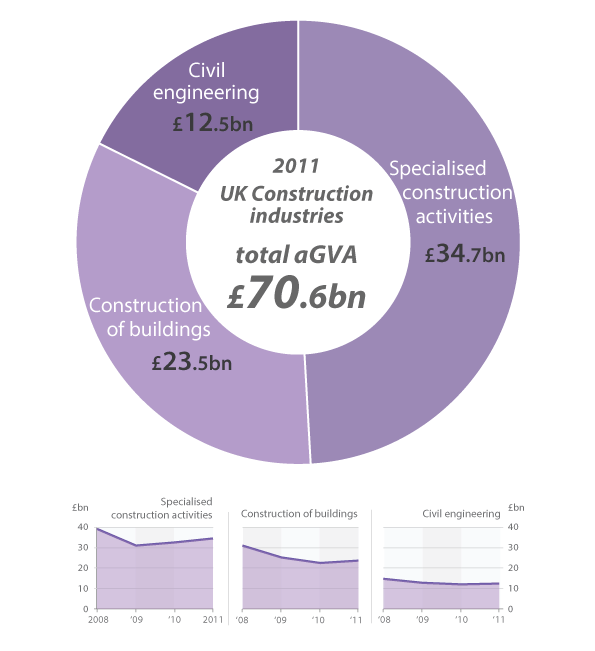
Source: Annual Business Survey (ABS) - Office for National Statistics
Notes:
- The sum of constituent items in this chart may not always agree exactly with the totals shown due to rounding
Specialised construction activities (division 43)
Specialised construction saw a 6.0% (£2.0 billion) increase in aGVA between 2010 and 2011, a result of a 7.8% (£5.7 billion) rise in turnover and a 9.8% (£4.0 billion) increase in purchases (see Figures 14 and 15). This is the only division within construction to have seen two consecutive annual increases in aGVA. This is thought to have been impacted to some extent by construction contracts in the run up to the London 2012 Olympics.
Construction of buildings (division 41)
Construction of buildings saw a small increase in aGVA of 3.8% (£0.9 billion) over the same period as a result of a 1.2% (£0.9 billion) fall in turnover and a 2.1% (£1.0 billion) increase in purchases.
Civil engineering (division 42)
Civil engineering showed a smaller increase in aGVA of 3.6% (£0.4 billion). While turnover increased by 4.3% (£1.6 billion) it was offset by a larger 7.6% (£1.9 billion) rise in purchases. The large increase in purchases for this division, and for specialised construction activities, are likely to have been impacted by rising material costs, particularly the price of steel.
Figure 15: Construction industries (section F), details of aGVA growth by division, 2008-2011
Revised 2011 United Kingdom data
Source: Annual Business Survey (ABS) - Office for National Statistics
Download this chart Figure 15: Construction industries (section F), details of aGVA growth by division, 2008-2011
Image .csv .xlsNotes for Construction industries (section F)
Please note that the ABS annual figures for the Construction industries should not be compared directly with annual figures in the monthly ‘Output in the Construction Industry’ release because:
- the two surveys measure different concepts of this industry
- while both quote figures for a calendar year, the ‘Output in the Construction Industry’ are based on the aggregate of the responses to 12 monthly surveys, whereas ABS figures are based on annual responses covering a range of business years
- the ABS figures will always be larger than those in the ‘Output in the Construction Industry’ because the latter excludes: Property developers (Group 41.1); Payment on purchased services (architects, technical engineering, etc.); Payment to subcontractors, unless the subcontractors are not classified to construction and therefore are not part of the survey; Value of land; Value of materials sold (which are not part of a structure); and Fixtures, equipment and tools that are sold
9. Agriculture (part), forestry and fishing (section A)
The ABS covers only hunting, forestry, fishing and the support activities to agriculture. Commentary is therefore limited because its size in terms of economic output, as measured by the ABS, is small in comparison to the other sections of the UK Business Economy. However, data for these parts of Section A can be found in the reference tables linked to this bulletin.
The other parts of agriculture, which include crop and animal production, are covered by the Department for Environment, Food and Rural Affairs (DEFRA).
The part of Section A covered by ABS showed rises in turnover of 11.3% between 2010 and 2011 (£0.4 billion) and purchases of 8.4% (£0.2 billion) giving a growth in aGVA between 2010 and 2011 for the first time in three years (8.9%, £0.1 billion). However, at £1.6 billion, aGVA still remains £0.1 billion lower than the level in 2008, at the start of the recession.
Validation of data returns for 2011 highlighted a small number of businesses within agriculture (Division 01) which needed to be reclassified resulting in revisions to the 2011 and 2010 figures. In line with the ABS revisions policy previous years (2008 and 2009) have not been revised and users should therefore take caution when comparing figures overtime.
Nôl i'r tabl cynnwys
